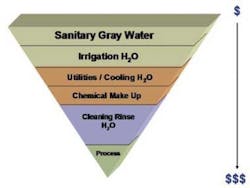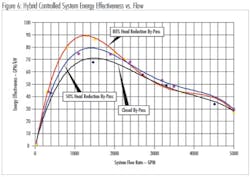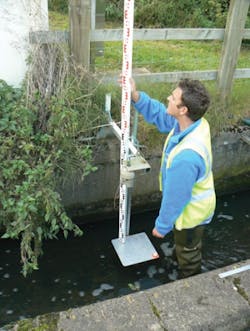Great Power, Great Responsibility
April 2010 marked the one–year anniversary in the UK since the introduction of a requirement for water companies to monitor their own effluent levels. Tom Freyberg speaks to the environment regulator and utilities to find out how this process has gone.
It's not often that self–regulation is imposed on companies in the UK. Numerous regulations driven from the government or Brussels, together with regulatory bodies, are responsible for making sure companies stick to the law. It was in April 2009 that change hit home and water companies had to start taking on more responsibilities for their effluent.
Prior to this date and under former UK regulations, the Environment Agency (EA) and Scottish Environment Protection Agency (SEPA) collected "end of pipe" samples of effluent from wastewater facility discharges. Such information was used to check compliance with the conditions of consent to discharge.
Costs of these site checks were levied back to companies under the "polluter pays" principle, determined by the size of the discharge. Consent parameters at the facilities included suspended solids, biological oxygen demand, ammonia, chemical oxygen demand and temperature.
It was in 2009, as part of a four–year plan, that the EA and SEPA starting phasing in Operator and Pollution Risk Appraisal (OPRA) and Operator Self Monitoring (OSM). OPRA assesses the environmental risks of effluent discharges based on a number of different attributes, including size and location of the discharge and the performance by the wastewater plant operator. OSM passes the responsibility for collecting, analysing and reporting discharge quality to the wastewater plant operators.
OPRA applies to all sizes of companies, across all industry sectors and types of discharges to the water environment. OSM has to be implemented by all companies that produce discharges that pose a "significant risk" to the environment.
The aim, according to the Agency, was to "encourage businesses to take greater responsibility for their actions and reduce the impact they have on the environment". But do the wastewater facility operators see it this way? The shift in responsibility would now mean that companies would foot the bill for the appropriate equipment and staff training but wouldn't have to pay the government regulators the previous fees.
Wessex Water is one utility that expresses minor concerns about the move to OSM but accepts it as a new obligation. "Since 1 April 2009 we have experienced some difficulties running the sampling programme in all conditions, while meeting the terms of the strict quality management system which controls the operation," says Ian Drury, a spokesman for Wessex Water.
"However we have found there have been advantages in analytical results being available more quickly from our own laboratories, which gives us immediate feedback on our compliance position, and allows a quick response to any problems that are detected."
In order for companies to monitor and analyse samples of effluent from their own discharge to an agreed standard, firms are required to meet the Monitoring Certification Scheme (MCERTS). They then have to send these monitoring results back to the EA which will audit and carry out site inspections to check performance.
According to SIRA, which was appointed by the EA in 2003 to operate the MCERTS scheme, it is important that effluent samplers require knowledge about the "mass release rate of pollutants". This is achieved by combining flow measurement data (volume/time) with pollutant concentration (mass/volume). To conform with requirements, companies must be able to demonstrate their flow monitoring arrangements are capable of monitoring effluent flow to within the EA target of ±8% of total daily volume.
Such changes and requirements, therefore, clearly needed to be thought through thoroughly and cannot simply be introduced overnight. However, the Chartered Institution of Water Environmental Management (CIWEM) says water companies have "self monitored" for drinking water quality for some time with "no apparent issues".
The process is audited rather than checking all the results. And the private sector operators, under Wastewater PFIs in Scotland, have self–monitored for discharge standards (and thus payment penalties) for 10 years and more, without significant problems, the institution adds.
Despite such experience with self monitoring, the integration of OSM didn't come without hiccups. "One of the main challenges was transferring sampling activity from the EA teams to our own teams in a busy time leading up to the periodic review," says Clive Harward, head of WQ&EP at Anglian Water Services. "To accommodate this we had to make sure the right resources were in place, recruit new staff and make sure they were trained up...It was a significant challenge but the industry is used to taking on such challenges."
Harward says the experience of monitoring drinking water helped with the task.
"Although it was a significant challenge at a busy time, the industry has successfully implemented the changes required to ensure the smooth transfer of monitoring and reporting responsibilities under OSM," he says.
"Self monitoring is not new to the industry, for example we have been self monitoring drinking water compliance for some years now. This experience was extremely valuable in the transition to OSM and in ensuring its robust implementation by the industry."
Another utility says that key parts of the process for any monitoring programme are very similar, such as planning, scheduling, actually taking the sample, analysing and then monitoring the results. Many companies are using the same process model but applying it to wastewater.
It hasn't just been with drinking water that companies have had experience with monitoring either. The Urban Wastewater Treatment Directive, implemented in 1994, is designed to regulate the collection and treatment of wastewater from homes and industry.
This required companies to invest in building and improving treatment works and sewerage systems. To conform, the EA requires water companies to monitor their own discharges for compliance with the directive standards by collecting composite samples over 24–hour periods. Such self–monitoring compliance is audited by the Agency.
David Wickens, general manager for quality and the environment, Severn Trent Water, says many companies will have had sampling experience with the directive but this didn't put to bed worries over potential costs.
"Obviously this [OSM] was a significant increase in the level of self monitoring," he says. "That's where our nervousness came from – looking at the costs we had for a small scale scheme and scaling them up – we weren't sure whether the rebate that was due on the charging scheme would cover the costs of a larger programme that was entailed. In the end we were able to put it in place without it costing us any more, probably a touch less actually."
The issue of cost, and whether the introduction of OSM will cost companies more than if they were to carry on paying the Agency, is one that is continuously raised. However, the belief that the Agency is actually saving money by withdrawing its effluent inspections is a misunderstanding, according to Andy Rogers, water quality policy manager at the EA.
"It's a misconception that the EA is actually saving money by shifting responsibility to the operators," he says. "The charges we levy have to be cost reflective – we rebate the costs we save and the savings transfer from the EA to water companies."
Wessex Water's Drury says costs have worked out about the same, despite the initial expense. "The costs of implementing OSM have been more than expected, but are broadly cost neutral," he says. "We await more information on future charging for the OPRA scheme so that its impact on our charges can be assessed also."
Costs or no costs, certain companies pre–empted legislative changes with OSM and were already undertaking effluent monitoring, according to Wickens.
"Some water companies, by the sounds of it, were duplicating a monitoring programme of their own for sewage works effluent, in which case to cease doing the EA monitoring to match their requirements was a fairly easy transition," he says. "So there were some willing to start as soon as possible and to get some financial benefit out of it.
"There were others, and we were in this category, where we had stopped a long time ago doubling up on samples that the EA was taking and for us it was a question of putting in place something that wasn't there to start with. Hence, that was partly why there were concerns over the potential costs." The general manager for quality and the environment believes that introducing the scheme after the dust has settled from the initial launch date in April 2009 enabled the company to learn from other companies.
"As we were starting from scratch in setting up a new programme we agreed with the EA that we would start on Jan 1 2010. In doing that we probably benefitted from clarification that came from those that started on April 1 2009. So if there were any teething issues that were clarified there, we had the benefit of it."
Overall it seems the programme to date has been a success. The Environment Agency is happy; utilities are happy and work is carrying on as usual.
Monitoring effluent levels is not a simple task and requires companies to take on such responsibility appropriately. The introduction of OSM hasn't been without issues and companies that have grasped the nettle, during a deepening economic crisis, should be applauded.
More Water & WasteWater International Current Issue Articles
More Water & WasteWater International Archives Issue Articles




